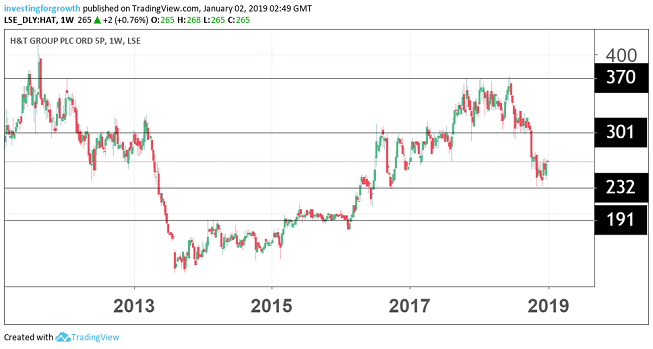Stockwatch: New Year update could re-rate this fallen star
2nd January 2019 09:02
by Edmond Jackson from interactive investor
Despite nerves ahead of the upcoming Christmas reporting season, companies analyst Edmond Jackson thinks there's a good chance of a 'relief rebound' for this AIM share.

Have the AIM-listed shares in pawnbroking, gold trading and personal loans firm H&T Group sold off too far? From the start of 2015 they advanced nicely from 150p to reach 370p mid-2018, then plunged 35% to a recent low of 242p. They’re currently worth around 260p.
In my latest macro piece, I noted how smaller financial companies are looking hard-hit given no adverse changes reported as yet. Asset managers will to some extent be affected by a reduction in the value of equity funds, translating into management fees, also if a material change in client sentiment affects fund purchases/redemptions. But with gold prices recovering since October and pawnbroking tending to thrive in a recession, H&T may have at least reached a support level.
If the group meets expectations for high single-digit earnings growth, then its prospective price/earnings (PE) ratio is around 9 times, generating a 4.2% yield thrice covered. The stock has twice tested a low at the 240p area, which could be interpreted as a 4.5% yield providing support.
Obviously, there are plenty of useful yields at the moment – the challenge is to avoid surprise warnings – and the PE is arithmetically in line with fundamentals, so, on a cautious view of UK consumer behaviour, such pricing could be reasonable enough.

Source: TradingView (*) Past performance is not a guide to future performance
Pawnbroker bosses have bought shares
Last September, H&T's chief executive bought 25,000 shares at 310p to own 1,104,530 overall, which, with hindsight, was premature but may still be true to his sense for underlying value. And at Ramsdens Holdings, a smaller AIM-listed pawnbroker (albeit deriving about a third of annual profit from foreign exchange, unlike H&T) its chief executive has also bought the drop: 48,484 shares at 165p to own 1,139,734 overall, straight after the interim results on 28 November.
As at H&T, Ramsdens hit a lower price of 150p and has recovered some poise. Its numbers for six months to 30 September showed jewellery retail revenue up 27% to £4.5 million, pawnbroking income up 5% to £6.8 million and precious metals trading up 6.2% to £6.2 million; only foreign exchange income down 2% to £7.3 million took a bit of shine off performance. Unless something has gone seriously wrong near the year-end, the trading context appears fair.
Early January update could provide a lift
My reason for drawing attention to H&T is a pre-close trading update due imminently, which if 'in line', should relieve fears. A key question is whether Black Friday and pre-Christmas sales of jewellery/watches fell enough to compromise group financials.
Interims to 30 June showed retail sales were up 7.2% to £16.4 million, although gross profit only by 1.7% to £6 million due to more new items to supplement those being pawned. This element represented 24% of group revenue and 14% of gross profit, so retail will have needed to plunge late-year to compromise group performance.
Another aspect I alluded to in my macro piece, is demand for personal loans potentially falling away in a consumer downturn. Interims cited such net revenue up 72.2% to £3.1 million with the loan book up 79.1% to £17.8 million – the driving factor said to be “continued development of the store business, supplemented by online and broker-to-store third party relationships” than any fleeting spike in demand.
In any case "we do not expect this level of book growth to continue," although summing up the outlook as of last August, the chief executive had said: "demand for small-sum, short-term cash loans remains strong."
A chief risk in a downturn would be a jump in defaults, as note 2 in the interims' segmental reporting shows personal loans generating £10.5 million of external revenue offset by £7.4 million impairments (hence £3.1 million net revenue), but the firm does say "we have made progress helping customers rebuild their credit rating."
| H&T Group - financial summary | Consensus estimates | ||||||
|---|---|---|---|---|---|---|---|
| year ended 31 Dec | 2013 | 2014 | 2015 | 2016 | 2017 | 2018 | 2019 |
| Turnover (£ million) | 99.3 | 87.7 | 89.2 | 94.2 | 110 | ||
| IFRS3 pre-tax profit (£m) | 6.7 | 5.5 | 6.8 | 9.7 | 14.1 | ||
| Normalised pre-tax profit (£m) | 7.7 | 5.8 | 6.9 | 10.3 | 14.7 | 14.2 | 16.5 |
| Operating margin (%) | 8.4 | 7.3 | 8.3 | 11.3 | 13.7 | ||
| IFRS3 earnings/share (p) | 13.4 | 11.8 | 14.9 | 20.9 | 20.9 | ||
| Normalised earnings/share (p) | 16.1 | 12.7 | 15.1 | 22.7 | 30.9 | 33.7 | 36.3 |
| Earnings per share growth (%) | -55.1 | -21.2 | 18.6 | 50.6 | 36.3 | 8.9 | 7.7 |
| Price/earnings multiple (x) | 10.2 | 9.4 | 8.7 | ||||
| Historic annual average P/E (x) | 6.2 | 10.2 | 14.6 | 15.7 | 13.2 | 10.4 | |
| Price/earnings to growth (x) | 0.2 | 0.9 | 0.9 | ||||
| Cash flow/share (p) | 42.7 | 39.8 | 31.0 | 3.6 | -9.5 | ||
| Capex/share (p) | 6.8 | 3.0 | 3.3 | 5.1 | 4.7 | ||
| Dividend per share (p) | 10.2 | 4.8 | 6.2 | 8.4 | 9.6 | 11.0 | 11.5 |
| Dividend yield (%) | 3.7 | 4.2 | 4.4 | ||||
| Covered by earnings (x) | 1.6 | 2.6 | 2.4 | 2.7 | 3.7 | 3.1 | 3.2 |
| Net tangible assets per share (p) | 187 | 196 | 205 | 218 | 287 | ||
Source: Company REFS Past performance is not a guide to future performance
De-rating also links to year-end doubts over retailers
Buyers are likely cautious, given it is over four months since H&T's interims and the company did not issue a trading update on 3 November like it has in the previous two years; although in 2016 this was to guide profits above the top end of expectations due to a higher sterling gold price after the EU referendum, and in 2017 similarly to guide profit expectations higher after firming gold prices had benefited the pawnbroking scrap and gold purchasing operations. So, if nothing has changed to alter expectations, an update wasn't required.
Meanwhile, investor sentiment towards retail has suffered after some stark warnings – partly due to "Black Friday" in late November causing a sales vacuum before Christmas, also Brexit uncertainties weighing on consumer confidence.
While H&T's chief executive asserted a "solid" first half at the 14 August interims, with pre-tax profit up 10.9% to £6.1 million on revenue up 18.7% to £68.5 million, his narrative included "a more challenging trading environment with high street footfall reductions and localised competitor activity." Thus, a chief question for the imminent update: has this intensified for the pawnbroking/retail operations?
On the basis of Ramsdens' update they should not have, although clothing retailer Bonmarche was positive in outlook at its 20 November interims then was clobbered by Black Friday and its aftermath, leading to a profit warning on 13 December. Possibly Bonmarche has marketing failures but, on that same day, Mike Ashley of Sports Direct wrote of "the worst November for retailers in living memory."
Strengthening gold prices from October should have supported H&T's gold purchasing side, although it is small in group context: at £2.1 million, barely 5% of the group’s interim gross profit.
Underlying risk is more likely medium-term
An overall firm update for the second half of 2018 looks likely, with forecasts in line, hence I target a "relief rebound" to 300p, representing a PE around 8.5 times and yield just shy of 4%.
Speculators might want to consider a position ahead of this, while investors will want to be quick off the mark if news reassures. Thereafter, a medium-term bull case will need to climb a wall of worry, consumer behaviour now being very hard to predict. H&T's end-June balance sheet had £25.9 million debt, all longer-term, and £18.1 million goodwill/intangibles, in context of £103 million net assets, a fair-enough balance sheet to withstand downtown.
By comparison at 170p, Ramsdens trades on a PE around 11 times, yielding just over 2%, a dichotomy traders may pick up on to push H&T shares higher in the short term.
You could accuse me of being a stale bull having drawn attention to H&T early last January as a 'buy' at 345p after a bullish pre-close update that pointed to further upgrades, though earning per share (EPS) projected into a 30p range like I suggested, has come about.
Following interims in August I thought at 316p the fair stance to be 'Add', but the stock had fallen 23% to 242p by December. The macro context is significantly responsible with small caps being hit, though H&T’s drop still looks overdone. Speculative buy.
*Horizontal lines on charts represent levels of previous technical support and resistance.
Edmond Jackson is a freelance contributor and not a direct employee of interactive investor.
These articles are provided for information purposes only. Occasionally, an opinion about whether to buy or sell a specific investment may be provided by third parties. The content is not intended to be a personal recommendation to buy or sell any financial instrument or product, or to adopt any investment strategy as it is not provided based on an assessment of your investing knowledge and experience, your financial situation or your investment objectives. The value of your investments, and the income derived from them, may go down as well as up. You may not get back all the money that you invest. The investments referred to in this article may not be suitable for all investors, and if in doubt, an investor should seek advice from a qualified investment adviser.
Full performance can be found on the company or index summary page on the interactive investor website. Simply click on the company's or index name highlighted in the article.
Disclosure
We use a combination of fundamental and technical analysis in forming our view as to the valuation and prospects of an investment. Where relevant we have set out those particular matters we think are important in the above article, but further detail can be found here.
Please note that our article on this investment should not be considered to be a regular publication.
Details of all recommendations issued by ii during the previous 12-month period can be found here.
ii adheres to a strict code of conduct. Contributors may hold shares or have other interests in companies included in these portfolios, which could create a conflict of interests. Contributors intending to write about any financial instruments in which they have an interest are required to disclose such interest to ii and in the article itself. ii will at all times consider whether such interest impairs the objectivity of the recommendation.
In addition, individuals involved in the production of investment articles are subject to a personal account dealing restriction, which prevents them from placing a transaction in the specified instrument(s) for a period before and for five working days after such publication. This is to avoid personal interests conflicting with the interests of the recipients of those investment articles.